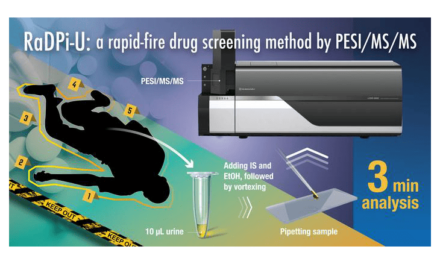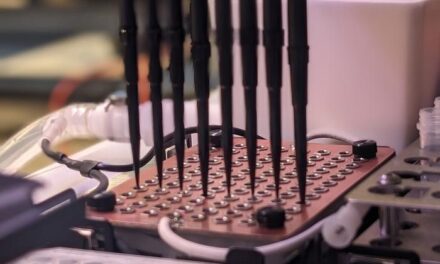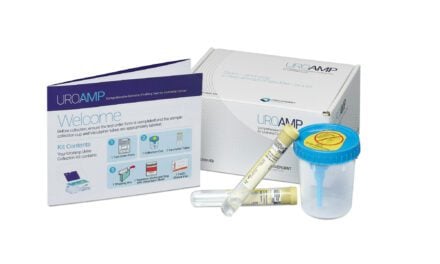Thoughtful automation aims for a new level of standardization and workflow efficiency
By Danette Godfrey, MS, MT(ASCP)
Today’s laboratories are pressured to produce accurate, valid, and high-quality results that provide clinical value to the physician, all while meeting turnaround time expectations with less staff and tightened budgets. To succeed in such an environment, many labs are taking advantage of advanced analyzers and companion systems that offer scalable automation and new levels of standardization, quality assurance, and workflow efficiency (Figure 1).
State of Urinalysis
System manufacturers first introduced the use of flow cytometry to automate the quantitative analysis of formed elements in urine in 1995. This achievement led to a reduction in the fundamental need for laboratory technicians and technologists to perform manual microscopy in the urinalysis department. However, samples that were flagged as abnormal by the analyzers still needed to be confirmed visually, so laboratories continued to centrifuge samples and perform sediment reviews via microscopy.
In 2016, improvements in automation brought standardization to urinalysis testing. Today, clinical laboratories are focusing on integrated systems with features such as calibration, sample transport technology, and test scheduling capabilities. However, many such systems remain incomplete, lacking the benefits of either flow cytometry or urine digital imaging. Now, in 2019, an innovation in urinalysis enables laboratories to rethink existing processes and consider options never available to laboratory professionals in the past. In the realm of urinalysis, the future of innovation is now.
Responding to Market Needs
Advances in the field of urinalysis are typified by the UF-5000 from Sysmex America, Lincolnshire, Ill, a fully automated urine particle analyzer that eliminates time-consuming hands-on review by screening samples suspected of containing pathological elements. The analyzer provides the technology of fluorescence flow cytometry, and employs a powerful blue semiconductor laser that offers enhanced detection and differentiation of small particles. Two new analysis channels are also introduced, enhancing the sensitivity and specificity of particle detection in urine sediment. The core channel stains elements with nuclear materials, such as white blood cells and bacteria, while the surface channel stains anucleate elements.
Important capabilities of the analyzer include flexible loading of samples, so that both routine and stat operations can be performed efficiently. The unit’s automated features also provide users with walkaway capability, improving ease of use and enabling technicians to focus on other tasks. To alert users when action is required, the system incorporates a light stick that provides color-coded cues visible throughout the laboratory. The system features an embedded intelligence processing unit and touchscreen modeled after the ‘silent design’ of Sysmex hematology analyzers. Sysmex’s silent design is the fusion of product design and technology, developed with users and their workplace in mind. Silent design systems offer a simplified user interface and method of operation based on careful study of laboratory processes, the relationship between the operator and the analyzer, and how people work.

Figure 1. To succeed in the field of urinalysis, many labs are taking advantage of advanced analyzers and companion systems that offer scalable automation and new levels of standardization, quality assurance, and workflow efficiency.
Because the UF-5000 can perform tests with very low specimen volumes, the system is well suited for testing among pediatric populations. UF-5000 customers also gain increased performance for the differentiation of casts. Radio frequency identification (RFID)-labeled fluorescent stain reagents result in efficient reagent management. This new feature enables easier reagent changes, in a small size. The system can autopopulate onboard reagent logs designed to increase operational efficiency. The UF-5000 employs diluents and stain reagents that enhance the sensitivity and specificity of particle detection, bringing accuracy, precision, and reproducibility to urinalysis testing.
A companion technology for advanced urinalysis is represented by the Sysmex UD-10, a urinalysis digital imaging system designed to capture images of particles in urine samples that require further review by a technologist. Capable of fully automated operation, the system provides operators with the freedom to walk away and perform other critical lab tasks while it collects images for later review. A high-quality digital camera provides detailed images of urine particles and allows the user to view full-field or individual particle images for improved classification. Customers can customize reflex criteria according to an individual laboratory’s needs. The detailed view of urine particles presented by the UD-10 instills operator confidence in urine particle identification.
Integration, at Last
While the UF-5000 and UD-10 are compact standalone analyzers that independently offer modern laboratories the latest technologies for automated urine sediment microscopic counts and particle imaging, there has remained a market need for an integrated urinalysis system that brings together all of these capabilities. Sysmex America has recently responded to this market need by combining the UF-5000 and UD-10 instruments to create the UN-2000, the company’s first fully automated urine particle counter and digital imaging system (Figure 2). By combining urine flow cytometry with digital imaging, the UN-2000 provides laboratories with a highly standardized and more efficient process for urine particle analysis that requires significantly less manual intervention time.
The UN-2000 retains the high-performance features of its component instruments, using fluorescence flow cytometry to deliver highly accurate particle quantitation and differentiation, applying standardized analytical criteria that result in highly reproducible quantitative measurements, and featuring walkaway loading that streamlines laboratory workflow. The high-quality images produced by the UN-2000’s digital camera, combined with user-definable rule settings, give labs more control over their process and analysis. Skilled users can quickly and easily classify pathogenic particles, essentially eliminating use of the microscope.
UN-2000 modularity and flexible configurations allow for increased throughput and simple, scalable options for upsizing and downsizing as the laboratory’s needs change. In addition, the UN-2000 reduces the need for manual specimen handling and data entry, thereby decreasing the opportunities for clerical errors.
Another key feature of the UN-2000 is the system’s use of the Sysmex Urine Data Manager (UDM), an intelligent data management program that provides users with an intuitive interface for ease of use, and a streamlined approach to the handling of urinalysis test results. By enabling the operator to manage instrument status and urinalysis data review on a single screen, the UDM improves the efficiency of laboratory urinalysis testing. UDM users can harness the power of customizable rules to further optimize their laboratories’ workflow and reduce the time to reportable urinalysis results.
Innovation in Quality Management
Advances in quality control and quality management practices also benefit the urinalysis laboratory. Performing laborious manual reviews of quality statistics is time consuming, and past systems have generally done little to support an efficient approach to meeting requirements for regulatory compliance.

Figure 2. The UN-2000 fully automated urine particle counter and digital imaging system from Sysmex America.
The UN-2000 system changes this paradigm by offering simplified and consolidated quality control with the BeyondCare Quality Monitor (BCQM) for urinalysis. The first quality management program of its kind, the BeyondCare program streamlines the end-to-end process of running controls and reviewing results. The program analyzes daily quality control and peer comparison data in real time to help detect any deterioration in the test method. Electronic reports and logs streamline the process of managing quality control data, and allow users to more quickly address and perform vital quality control functions.
In everyday operation, the BCQM program provides color-coded alerts that intuitively signify the results of quality control processes, and annotations that detail the system’s compliance status. A green status indicates that the system has passed all quality control processes, and is supplemented by automated documentation that provides a fail-safe annotation of all the actions performed by an individual user. With a yellow status, the program notifies the user of specific actions needed to troubleshoot the quality control run.
The BCQM program also alerts users when quality control procedures are due to be performed, providing another fail-safe mechanism to ensure that laboratory professionals are following laboratory-defined protocols. In the event that correction of a system error requires onsite service, the BCQM notifies and dispatches service technicians automatically, with no need for any action by the user. Customers can also access peer-group analytics and lot-to-lot quality control data, taking the guesswork out of quality control management.
Such inventive approaches to simplified, fully integrated, and automated analyzers lend themselves to Web-based quality control and system management. With online access, any authorized manager or user can connect to the BCQM program from any location, streamlining the process of running quality control procedures and verifying the acceptability of quality control results.
The BCQM program also eliminates the longstanding interruption of having to export quality control files in order to create Levey-Jennings charts. The program offers lot-to-lot reports that clearly define the effects of a new lot of reagents when compared to the quality control limits of the previous lot. The reports include color-coded overlays that can be annotated digitally, creating an easy-to-access report file that can alleviate anxiety on inspection day. The BCQM program offers users numerous management reports on demand, including peer-group reporting at the analyte level. Such features effectively end the need for paper logs; the results of confirmatory testing are stored directly in the program files, further reducing the risk of transcription or other documentation errors.
Middleware Tools
The advanced technologies of the UN-2000 system are integrated with Sysmex Work Area Manager (WAM), a middleware solution that can seamlessly connect multidisciplinary instruments across multiple sites to one or more laboratory information systems. Together, these advanced tools and powerful software systems are specifically designed to generate greater insight into—and control over—both processes and information, across the healthcare network. The system’s on-demand, consolidated management reports help laboratories to improve their operations, workflow, and productivity. Business intelligence reporting informs improvements in clinical performance, productivity, and staffing decisions. Mobile technology tools enable an entire organization to share analyzer performance histories, workflow analytics, and educational requirements.
Designed with the needs of urinalysis professionals in mind, the customizable WAM middleware helps laboratories manage data, connectivity, and workflow. UN-2000 customers additionally benefit from integration with the WAM middleware through easier standardization of testing protocols and results management across their entire healthcare organization.
Web-Based Training
Advanced instruments require equally sophisticated approaches to training, which plays a significant role in helping laboratories deal with the growing challenges of personnel shortages. Efficient and effective training ensures that laboratory staff are equipped with the diagnostic knowledge needed for laboratories to get the most out of their investments in both hardware and software. In-person training, regional symposia, and user groups are good options for continuing education. However, access to live events is inherently limited, and labs may incur considerable expense and inconvenience if many of their staff need to attend such sessions.
Conversely, Web-based training programs provided by the manufacturer ensure that all technologists receive standardized training, building consistent knowledge within a lab or across a lab network. Webinars, e-learning, and self-paced training platforms are generally more efficient and effective than live events, and can significantly reduce the costs of training employees.
Since 2003, training has been the centerpiece of a unique package of support that Sysmex America provides its customers in the United States and Canada. Each product purchase includes a number of training slots used by customers to help key staff develop the skills needed to operate their recently purchased equipment.
To meet the changing training needs of today’s time-pressed laboratories, in 2018 Sysmex opened a state-of-the-art center for learning. With this facility, Sysmex more than tripled its training capacity for offering virtual instructor-led training, which combines the best of conventional training, including live, instructor-led sessions that combine sharing information, performing hands-on exercises, and real-time question-and-answer opportunities with expert instructors.
Sysmex customers enjoy the personal, customized, and highly interactive nature of the virtual instructor-led training. High-definition core system classes are streamed to laboratories, enabling each lab to have hands-on experience with the Sysmex system being used. There are no limits to the number of technologists who can complete courses, or how often courses are completed, giving laboratories the ability to monitor their staff’s competency at any time.
Conclusion
Laboratories are experiencing the pressures of staffing challenges and declining reimbursement, combined with growing demands for improved results accuracy and workflow efficiency. Such challenges are making the need for new and innovative laboratory instruments increasingly apparent.
Laboratory purchasing decisions are commonly based on a system’s quality and reliability, but also take into account overall system flexibility and technological sophistication. Superior capabilities in all of these areas are needed to give technicians more time to apply their expertise in analyzing test results.
Danette Godfrey, MS, MT(ASCP), is director of in vitro diagnostic product marketing at Sysmex America Inc. For further information, contact CLP chief editor Steve Halasey via [email protected].






